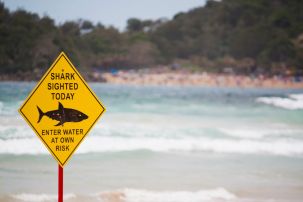Lesson summary
In this activity students work in groups to analyse media stories and stories from scientific agencies about Great White Sharks. The aim is to see if the media portrays scientific research on sharks in a particular way that differs from the message provided by the scientific agencies. They present the results of their analysis for discussion and comparison.
Learning intentions:
Students will...
- understand that the media uses a range of strategies and techniques to portray Great White Sharks, and can recognise some of these strategies and techniques.
- understand some of the science behind Great White Shark research.
Lesson guides and printables
Curriculum links
Select your curriculum from the options below.
Lesson details
Curriculum mapping
Australian Curriculum content descriptions:
Year 9 English:
- Interpret, analyse and evaluate how different perspectives of issue, event, situation, individuals or groups are constructed to serve specific purposes in texts (ACELY1742)
- Use comprehension strategies to interpret and analyse texts, comparing and evaluating representations of an event, issue, situation or character in different texts (ACELY1744)
- Explore and explain the combinations of language and visual choices that authors make to present information, opinions and perspectives in different texts (ACELY1745)
- Create imaginative, informative and persuasive texts that present a point of view and advance or illustrate arguments, including texts that integrate visual, print and/or audio features (ACELY1746)
- Use a range of software, including word processing programs, flexibly and imaginatively to publish texts (ACELY1748)
Year 10 English:
- Identify and analyse implicit or explicit values, beliefs and assumptions in texts and how these are influenced by purposes and likely audiences (ACELY1752)
- Use comprehension strategies to compare and contrast information within and between texts, identifying and analysing embedded perspectives, and evaluating supporting evidence (ACELY1754)
- Create sustained texts, including texts that combine specific digital or media content, for imaginative, informative, or persuasive purposes that reflect upon challenging and complex issues (ACELY1756)
- Review, edit and refine students’ own and others’ texts for control of content, organisation, sentence structure, vocabulary, and/or visual features to achieve particular purposes and effects (ACELY1757)
Syllabus Outcomes: EN5-1A, EN5-2A, EN5-8D.
Resources required
- Internet access
- Library access (optional)
- Student worksheet
- Lists of scientific sites and newspaper articles (see students worksheet)
Additional info
This is an original Cool.org lesson. Facts and figures in these lessons may have changed since this lesson was published. We always endeavour to update our resources in a timely manner, but if you see an error or issue in our resources please get in touch with us.


Welcome back!
Don't have an account yet?
Log in with:
Create your free Cool.org account.
Many of our resources are free, with an option to upgrade to Cool+ for premium content.
Already have an account?
Sign up with:
By signing up you accept Cool.org's Terms and Conditions(Opens in new tab) and Privacy Policy(Opens in new tab).